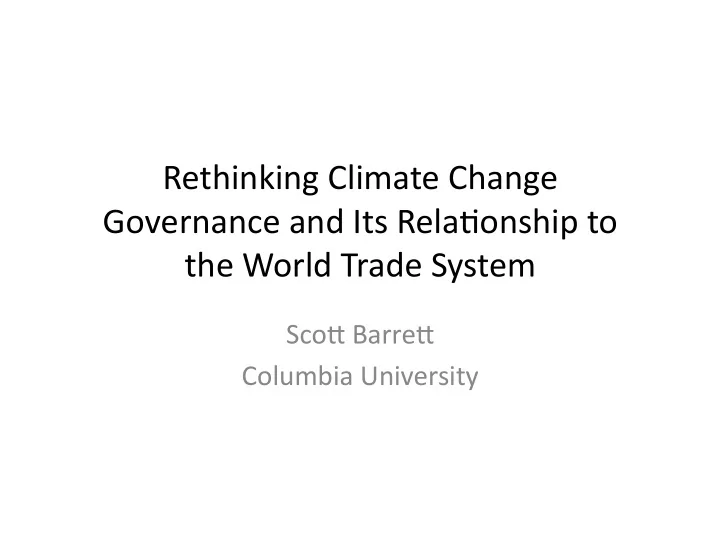

Rethinking Climate Change Governance and Its Rela6onship to the World Trade System Sco< Barre< Columbia University
Climate‐Trade Linkages • Emission reduc6ons – Trade leakage. Free trade frustrates efforts – Global energy markets. to reduce net emissions. • REDD • Climate related policies not linked to trade – Adapta6on. – Industrial “air capture.” – Geoengineering (“SRM”).
Climate‐Trade Policy Linkages • So far, climate and trade policy have not been linked formally. • But, so far, climate policy has been ineffec6ve. • And this may be partly because climate and trade policy have not been linked.
Status of Climate Nego6a6ons Cancun Rio Kyoto Copenhagen Durban 2010 1992 1997 2009 2011
Status of Climate Nego6a6ons × Cancun Rio Kyoto Copenhagen Durban 2010 1992 1997 2009 2011 2012 “Climate [change talks] are the most important nego6a6ons the world has ever seen, but governments, business and civil society cannot solve it in one mee6ng.” Chris6ana Figueres, execu6ve secretary UN Climate Change Secretariat Bonn, June 2011
Consequences? • With climate nego6a6ons failing, some countries may act unilaterally or minilaterally. • And link their climate policies to trade. • This may put the trade system at risk. – EU plans to extend ETS to interna6onal air transport. – H.R. 2454 (not law) possibly requires importers to obtain emission permits, when imports produced in countries lacking “comparable” emissions limits. – Sarkozy proposal to impose tariffs to address carbon leakage.
How to Move Forward? • Ul6mately, climate change needs to be addressed at the global level. • Might mul6lateral approaches succeed more if they formally linked climate policy to trade policy?
Reasons for Trade Restric6ons 1. Limi6ng/neutralizing leakage. – Rate higher, the greater the emission reduc6on and the smaller the number of countries ac6ng. – Leakage could be 0 < or > 100%. – For Kyoto, one es6mate ≈ 20%; actual, small. – $21/tCO2 Japan & EU‐15, leakage 55% iron and steel. – €20/tCO2 EU‐27, leakage 0.5‐25% iron and steel; 40‐70% cement. • In theory, a full BTA could neutralize leakage (except for energy markets). • In prac6ce, calcula6ng this very difficult.
Reasons for Trade Restric6ons 2. Punishing/limi6ng/deterring free riding. – Trade restric6ons would apply as between par6es and non‐par6es. – Primary intent would be to promote par6cipa6on. – Would also be used to punish/limit/deter non‐ compliance. – If par6cipa6on is full, leakage is 0! – In contrast to a BTA, can be crudely calculated.
Lessons from other IEAs
1911 North Pacific Fur Seal Treaty • To deter entry, treaty banned imports of non‐ authen6cated seal skins.
Interna6onal Conven6on for the Conserva6on of Atlan6c Tuna • To punish par6es and non‐par6es for IUU fishing.
Montreal Protocol • To deter non‐par6cipa6on.
Interna6onal Conven6on Preven6on of Marine Pollu6on from Ships • Prevents ships not complying with the standards from entering ports.
Interna6onal Civil Avia6on Organiza6on • Establishes standards, which par6es may adopt in na6onal laws, preven6ng aircraq that violate the standards from landing within its territory.
Why KP Does Not Incorporate Trade Restric6ons • Limits “produc6on” of emissions. By contrast MP limited produc6on and “consump6on.” The obliga6ons of KP are not geared to enforcement using trade restric6ons. • Enforcement mechanism was nego6ated later. – One component required “self punishment.” – Another suspension of emissions trading privileges. – Neither was adopted by amendment.
Diagnosis of Failure • Following Copenhagen, many people concluded that the process had to change. • Cancun reaffirmed, at least for now, support for the old process. • While that process has failed for 20 years, what must change is the approach .
Proposal for a New Treaty Design • A mul6ple of protocols, controlling different gases and sectors. • MP is already the best climate treaty, controlling numerous ODSs that happen also to be GHGs. • KP separated out interna6onal avia6on and marine transport. • Also, domes6c implementa6on controls sectors, not economy‐wide emissions.
Examples • HFCs . Under the MP; this would be global and enforced using trade restric6ons. • Avia)on . ICAO Programme of Ac6on to develop “the first globally‐harmonized agreement from a sector on a goal to address its CO 2 emissions.” • Iron and steel . Perhaps a new standard requiring that the Hlsarna steelmaking process replace the basic oxygen furnace process. – Trade would be restricted to countries complying with the standard. – Carrots as well as s6cks.
Examples (cont’d) • Automobiles . Interna6onal standard for the electric car and for recharging. • Electricity genera)on . Difficult because electricity is not highly traded and genera6on is not networked. • All new coal‐fired power plants CCS by 2020; all coal‐ fired power plants CCS 2050. – No “comparability problem.” – Compensa6on for “incremental costs” easy to determine. – Could supplement with trade restric6ons for par6cular sectors, such as aluminum manufacture.
Conclusions • Mul6lateral approaches to climate change are needed. The approach tried so far has failed. • It has failed mainly because of enforcement problems. • Failure may cause countries to adopt trade restric6ons unilaterally. • To address both problems, it would be be<er to try a new approach to treaty design, using trade restric6ons where appropriate to enforce par6cipa6on and compliance.
Recommend
More recommend